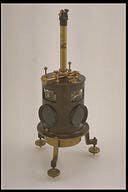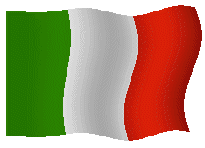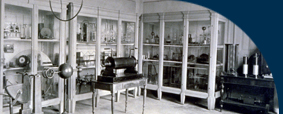
 |
Thomson-Mascart's quadrant electrometer |
 |
Elettrometro a quadranti di Thomson-Mascart |
| Subject: electrostatics/electric potential gauge |
Settore: elettrostatica/misuratore di potenziali elettrici |
| Number of catalogue: 29 |
Numero di inventario: 29 |
| Unsigned |
Non firmato |
| 1900 [document] |
Periodo di costruzione: 1900 [documento] |
| Brass, metallic alloy, glass, aluminium, platinum, silk |
Materiali utilizzati: Ottone, lega metallica, vetro, alluminio, platino, seta |
195 X 180 X 410 [mm] |
Dimensioni: 195 X 180 X 410 [mm] |
| |
|
This instrument with auxiliary field is a modified version of the quadrant electrometer devised and described for the first time in 1867 by the English physicist William Thomson (1824-1907, from 1892 Lord Kelvin). The French physicist Eleuthère Elie Nicolas Mascart (1837-1908) made some simple changes to Thomson's model to increase its sensitivity and precision. From a document it is evident that the instrument was purchased in 1900 by Aristide Fiorentino, Director of the "Gabinetto di Fisica" of the University of Urbino from 1899 to 1901. |
Questo strumento a campo ausiliario è una versione modificata dell'elettrometro a quadranti ideato e descritto per la prima volta nel 1867 dal fisico inglese William Thomson (1824-1907, dal 1892 Lord Kelvin). Il fisico francese Eleuthère Elie Nicolas Mascart (1837-1908) apportò al modello di Thomson alcune semplici modifiche che ne accrebbero la sensibilità e l'accuratezza. Dalla documentazione rinvenuta, risulta acquistato nel 1900 da Aristide Fiorentino, Direttore del Gabinetto di Fisica dell'Università di Urbino dal 1899 al 1901. |
| |
|
Description: The instrument, which is supported by three brass levelling screws, is enclosed in a protective cylindrical box of darkened brass. The upper part features four rectangular glass windows that display the quadrants and the lower part, at the level of the small mirror connected to the mobile equipment, with two circular windows in which two thick lenses are inserted. The metal box, which is placed on the ground and, therefore, with zero potential, acts as protection from any kind of external electrical influence. The instrument permits the measurement of unknown electric potentials by means of the angular deflection of a lightweight, eight-shaped aluminium needle, connected with a bifilar silk suspension that goes down along the axis of a cylindrical brass tube, which is inserted in the centre of the box lid and which is able to rotate through the manual rotation of a long brass screw. The needle is suspended within a cylindrical brass box, which is divided into four sectors (quadrants) that are clearly separated, symmetrical to the rotation axis of the needle, suspended and insulated within the box by four small glass columns that are fixed to the upper internal base of the covering. The diagonally placed quadrants are linked to one another through conducting wires and each pair is electrically connected with a binding post on the lid of the box. On the lower part the needle is connected to a platinum wire that holds a plane mirror the extremity of which is immersed in a small container (on the bottom of the cylinder) containing a concentrated solution of sulphuric acid. The platinum wire reaches the conducting solution by means of a double cross, which dampens the oscillation of the needle. The solution, which exerts adeguate hygroscopic insulation, is electrically connected with the third binding post of the lid of the box through a second platinum wire. |
Descrizione: Sostenuto da tre viti calanti d'ottone, lo strumento è rinchiuso e protetto da una scatola cilindrica d'ottone brunito, dotata superiormente di quattro finestrelle rettangolari in vetro per la visione dei quadranti e inferiormente, all'altezza dello specchietto collegato all'equipaggio mobile, di due finestre circolari nelle quali sono inserite due spesse lenti. La scatola metallica, posta a terra e quindi a potenziale nullo, agisce da schermo contro qualunque influenza elettrica esterna. Lo strumento permette di misurare potenziali elettrici incogniti tramite la deviazione angolare di un leggero ago di alluminio a forma di otto, collegato ad una sospensione bifilare in seta che scende lungo l'asse di un tubo cilindrico d'ottone, innestato centralmente sul coperchio della scatola e in grado di ruotare tramite la rotazione manuale di una lunga vite d'ottone. L'ago è sospeso entro una scatola cilindrica d'ottone, divisa in quattro settori (quadranti), ben separati, simmetrici rispetto all'asse di rotazione dell'ago, sospesi e isolati entro la scatola da quattro colonnine di vetro, fissate alla base superiore interna dell'involucro. I quadranti diagonalmente opposti sono collegati per mezzo di fili conduttori e ciascuna coppia è connessa elettricamente con un serrafilo posto sul coperchio della scatola. Inferiormente l'ago è collegato a un filo di platino che porta uno specchietto piano la cui estremità è immersa in una vaschetta, posta sul fondo del cilindro, contenente una soluzione concentrata di acido solforico. Il filo di platino pesca nella soluzione conduttrice per mezzo di una doppia croce, che serve a smorzare le oscillazioni dell'ago. La soluzione, che permette di assorbire l'umidità atmosferica, è in collegamento elettrico con il terzo serrafilo del coperchio della scatola mediante un secondo filo di platino. |
| |
|
Function: a common procedure of measurement consists of taking the needle to the unknown potential and charging the two pairs of sectors with constant potentials (for example, connecting them with the poles of a pile). The rotation of the needle is detected through the movement of a beam of light that strikes the small mirror and is reflected on an external scale of reference. An optical lever allows for the amplification of the rotation. The two lenses inserted in the electrometer have the following functions: the former focuses the beam on the small mirror and the latter focuses the reflected beam on the graduated scale. This was previously calibrated by means of known potentials. By applying the same potential to both pairs of quadrants, the needle places itself symmetrically (the zero of the graduated scale is therefore determined). And, vice versa, by applying different potentials to the pairs of quadrants, the symmetry is not preserved. The needle and the small mirror rotate until the electrical forces are balanced by the elastic forces of the double wire of the mobile equipment and by the friction forces acting on the double cross blade. |
Funzionamento: un procedimento ordinario di misura consiste nel portare l'ago al potenziale incognito e nel caricare le due paia di settori a potenziali costanti (collegandoli, ad esempio ai poli di una pila). La rotazione dell'ago viene registrata tramite lo spostamento di un pennello di luce che incide sullo specchietto e viene riflesso su una scala di riferimento esterna. Una leva ottica permette di amplificare queste rotazioni. Le due lenti inserite nella struttura dell'elettrometro hanno le seguenti funzioni: l'una di focalizzare il fascio sullo specchietto, l'altra di focalizzare il fascio riflesso sulla scala graduata. Questa viene precedentemente tarata per mezzo di potenziali noti. Applicando il medesimo potenziale ad entrambe le coppie di quadranti, l'ago si dispone simmetricamente (viene così fissato lo zero sulla scala graduata). Viceversa, fornendo potenziali diversi alle coppie di quadranti, la simmetria non si conserva. L'ago e lo specchietto ruotano fino a che le forze elettriche non vengano bilanciate dalle forze elastiche del doppio filo dell'equipaggio mobile e dalle forze di attrito agenti sulla paletta a doppia croce.
|
| |
|
Bibliography: Mascart [1888], pp. 190-191; Jamin [1890], tome IV, part 1, file 1, pp. 256-257. |
Bibliografia: Mascart [1888], pp. 190-191; Jamin [1890], tome IV, partie I, fasc. 1, pp. 256-257.
|
|
|

